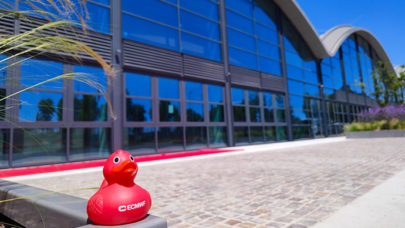
Meet TempoQuest, a Startup Bringing Weather Code Into the Accelerated Era
April 18, 2023
Weather and climate applications are some of the most important for high-performance computing, often serving as raisons d'être and flagship workloads for the Read more…

Citing ‘Shortfalls,’ NOAA Targets Hundred-Fold HPC Increase Over Next Decade
January 5, 2022
From upgrading the Global Forecast System (GFS) to acquiring new supercomputers, the National Oceanic and Atmospheric Administration (NOAA) has been making big moves in the HPC sphere over the last few years—but now it’s setting the bar even higher. In a new report, NOAA’s Science Advisory Board (SAB) highlighted... Read more…

Climavision Targets Weather Forecasting Through HPC Cloud Bursts
January 4, 2022
If Climavision isn’t on your radar just yet, that’s understandable: the company launched from stealth just six months ago, emerging in June with a formidable $100 million in funding. Its promise: to roll out a combination of numerical weather prediction (NWP), AI, traditional weather observations, satellite data... Read more…

ECMWF Opens Bologna Datacenter in Preparation for Atos Supercomputer
September 14, 2021
In January 2020, the European Centre for Medium-Range Weather Forecasts (ECMWF) – a juggernaut in the weather forecasting scene – signed a four-year, $89-million contract with European tech firm Atos to quintuple its supercomputing capacity. With the deal approaching the two-year mark, ECMWF... Read more…

NOAA Upgrades Its Flagship Global Forecast System (Again)
March 22, 2021
When it rains, it pours: the National Oceanic and Atmospheric Administration has announced another major upgrade to the U.S.’ Global Forecast System (GFS). Th Read more…

NOAA Announces Major Upgrade to Ensemble Forecast Model, Extends Range to 35 Days
September 23, 2020
A bit over a year ago, the United States’ Global Forecast System (GFS) received a major upgrade: a new dynamical core – its first in 40 years – called the finite-volume cubed-sphere, or FV3. Now, the National Oceanic and Atmospheric Administration (NOAA) is bringing the FV3 dynamical core to... Read more…

Could Machine Learning Replace the Entire Weather Forecast System?
April 27, 2020
Just a few months ago, a series of major new weather and climate supercomputing investments were announced, including a £1.2 billion order for the world’s mo Read more…

Microsoft Announces General Availability of AMD-backed Azure HBv2 Instances for HPC
February 27, 2020
Nearly seven months after they were first announced, Microsoft Azure’s HPC-targeted HBv2 virtual machines (VMs) based on AMD second-generation Epyc processors Read more…

- Click Here for More Headlines

Whitepaper
Transforming Industrial and Automotive Manufacturing
In this era, expansion in digital infrastructure capacity is inevitable. Parallel to this, climate change consciousness is also rising, making sustainability a mandatory part of the organization’s functioning. As computing workloads such as AI and HPC continue to surge, so does the energy consumption, posing environmental woes. IT departments within organizations have a crucial role in combating this challenge. They can significantly drive sustainable practices by influencing newer technologies and process adoption that aid in mitigating the effects of climate change.
While buying more sustainable IT solutions is an option, partnering with IT solutions providers, such and Lenovo and Intel, who are committed to sustainability and aiding customers in executing sustainability strategies is likely to be more impactful.
Learn how Lenovo and Intel, through their partnership, are strongly positioned to address this need with their innovations driving energy efficiency and environmental stewardship.
Download Now
Sponsored by Lenovo
Whitepaper
How Direct Liquid Cooling Improves Data Center Energy Efficiency
Data centers are experiencing increasing power consumption, space constraints and cooling demands due to the unprecedented computing power required by today’s chips and servers. HVAC cooling systems consume approximately 40% of a data center’s electricity. These systems traditionally use air conditioning, air handling and fans to cool the data center facility and IT equipment, ultimately resulting in high energy consumption and high carbon emissions. Data centers are moving to direct liquid cooled (DLC) systems to improve cooling efficiency thus lowering their PUE, operating expenses (OPEX) and carbon footprint.
This paper describes how CoolIT Systems (CoolIT) meets the need for improved energy efficiency in data centers and includes case studies that show how CoolIT’s DLC solutions improve energy efficiency, increase rack density, lower OPEX, and enable sustainability programs. CoolIT is the global market and innovation leader in scalable DLC solutions for the world’s most demanding computing environments. CoolIT’s end-to-end solutions meet the rising demand in cooling and the rising demand for energy efficiency.
Download Now
Sponsored by CoolIT
Advanced Scale Career Development & Workforce Enhancement Center
Featured Advanced Scale Jobs:
HPCwire Resource Library
HPCwire Product Showcase
© 2024 HPCwire. All Rights Reserved. A Tabor Communications Publication
HPCwire is a registered trademark of Tabor Communications, Inc. Use of this site is governed by our Terms of Use and Privacy Policy.
Reproduction in whole or in part in any form or medium without express written permission of Tabor Communications, Inc. is prohibited.
























